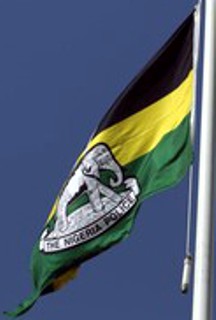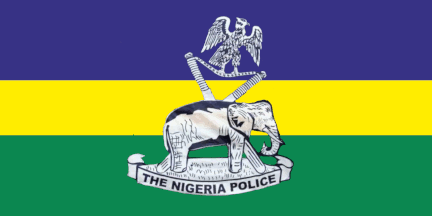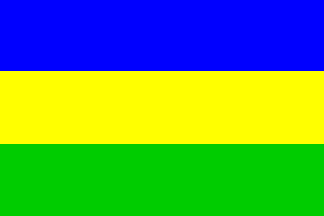 image located by Dave Fowler
image located by Dave Fowler
Last modified: 2025-07-26 by bruce berry
Keywords: police: nigeria | tribar |
Links: FOTW homepage |
search |
disclaimer and copyright |
write us |
mirrors
 image by Zoltan Horvath,
10 August 2024
image by Zoltan Horvath,
10 August 2024 At
this site [expired, not retrievable] shows a variant of the police flag but with a thinner central yellow
stripe and with the police badge superimposed centrally (picture).
Jason Saber, 7 December 2015
See also:
In April 1861, the British Consul in Lagos obtained permission from his principal in London to establish a Consular Guard comprising of 30 men.
Two years later in 1863, this small body of men became known as the "Hausa Guard". It was further regularized in 1879 by an Ordinance creating a Constabulary for the Colony of Lagos. An Inspector-General of Police commanded this Force recruited mainly from Hausas and known as the "Hausa Constabulary".
On 1st January 1896, the Lagos Police Force was created and armed like the "Hausa Constabulary". While the developments were taking place in Lagos and part of the Yoruba heartland, the areas now known as Edo, Delta, Akwa Ibom, River and Cross River States were declared the Oil Rivers protectorate in 1891 with Headquarters at Calabar where an armed constabulary was formed. In 1893 the area was proclaimed the Niger Coast Protectorate. A Constabulary, modeled on the Hausa Constabulary, was formed. It existed for six years and featured prominently in the British expedition to Benin in 1896.
In the Northern parts of the terriory, the Royal Niger Company, which was granted a Royal Charter in 1886 by the British Government, set up the Royal Niger Constabulary in 1888 with Headquarters at Lokoja to protect its installations along the banks of the River Niger. It had a mounted company known as Carrol’s Hoses. The Royal Niger Constabulary played an important role in British campaigns against Bida and Ilorin.
When the British Government in 1900 following the transfer of administration from the Royal Niger Company proclaimed protectorates of Northern and Southern Nigeria, the Royal Niger Constabulary was split into the Northern Nigeria Police Force and the Northern Nigeria Regiment.
In the South, the Lagos Police Force and part of the Niger Coast Constabulary became the southern Nigeria Police Force in 1906 while the bulk of the Niger Coast Constabulary formed the southern Nigeria Regiments.
After the amalgamation of Northern and Southern Nigeria in 1914, both
Police Forces continued to operate separately until 01 April 1930 when they
were merged to form the present Nigeria Police Force with its headquarters in
Lagos. Nigerians assumed overall leadership of the Force in 1964 when
the late Mr. Louis Orok Edet was appointed the first indigenous
Inspector-General of Police. Since then ten other Nigerians, including the
present incumbent Mr. Tafa A Balogun, have held the Office (Source:
http://www.nigeriapolice.org/history.html).
Ivan Sache, 4 October 2002
A variant of the Police Flag (source).
Dave Fowler, 3 February 2024
 image by Ivan Sache,
4 October 2002
image by Ivan Sache,
4 October 2002 The flag of the Nigeria Police Force comprises of three equal horizontal stripes of blue-yellow-green. The meaning of the colours is the following:
* blue: love, loyalty and unity
* yellow: discipline and resourcefulness
* green: energy and life.
(The very same flag is also shown on the Kanowra page, attributed by James Minahan (Nations Without States [eba94]) to "the Kanuri national movement").
Ivan Sache, 4 October 2002
pol.jpg) image located by Jason Saber
image located by Jason Saber
I have come across the attached image of the Nigerian police badge. On the
left side of the emblem is the Nigerian national flag and what appears to be the
flag used by the Nigerian police if on the right side of the emblem.
However, these colours are presented are shown as a horizontal tricolour above
whilst this version on the badge has the colours displayed vertically.
Which is correct? Or are the colours on the badges a stylistic variation to
maintain symmetry?
Jason Saber, 7 December 2015